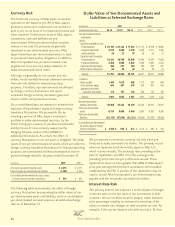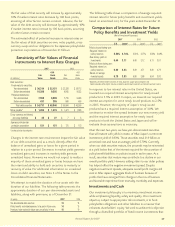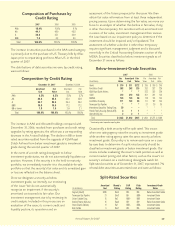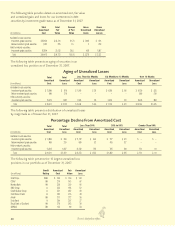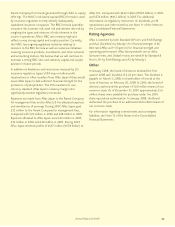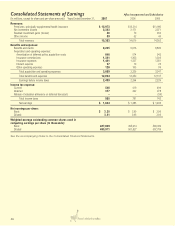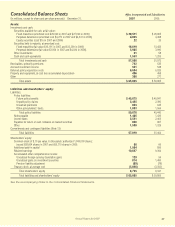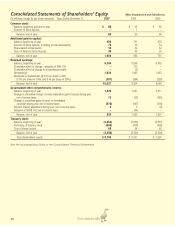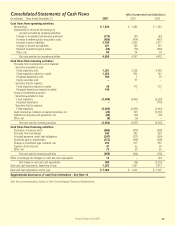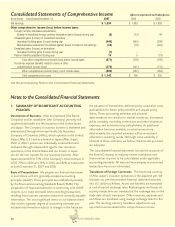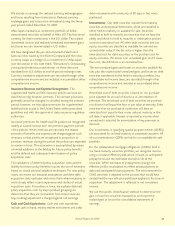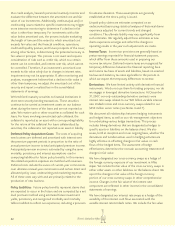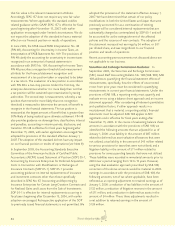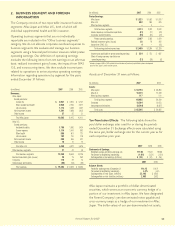Aflac 2007 Annual Report Download - page 49
Download and view the complete annual report
Please find page 49 of the 2007 Aflac annual report below. You can navigate through the pages in the report by either clicking on the pages listed below, or by using the keyword search tool below to find specific information within the annual report.
45
Annual Report for 2007
Parent Company from funds generated through debt or equity
offerings. The NAIC’s risk-based capital (RBC) formula is used
by insurance regulators to help identify inadequately
capitalized insurance companies. The RBC formula quantifies
insurance risk, business risk, asset risk and interest rate risk by
weighing the types and mixtures of risks inherent in the
insurer’s operations. Aflac’s RBC ratio remains high and
reflects a very strong capital and surplus position. Currently,
the NAIC has ongoing regulatory initiatives relating to
revisions to the RBC formula as well as numerous initiatives
covering insurance products, investments, and other actuarial
and accounting matters. We believe that we will continue to
maintain a strong RBC ratio and statutory capital and surplus
position in future periods.
In addition to limitations and restrictions imposed by U.S.
insurance regulators, Japan’s FSA may not allow profit
repatriations or other transfers from Aflac Japan if they would
cause Aflac Japan to lack sufficient financial strength for the
protection of policyholders. The FSA maintains its own
solvency standard. Aflac Japan’s solvency margin ratio
significantly exceeds regulatory minimums.
Payments are made from Aflac Japan to the Parent Company
for management fees and to Aflac U.S. for allocated expenses
and remittances of earnings. During 2007, Aflac Japan paid
$32 million to the Parent Company for management fees,
compared with $25 million in 2006 and $28 million in 2005.
Expenses allocated to Aflac Japan were $33 million in 2007,
$32 million in 2006 and $30 million in 2005. During 2007,
Aflac Japan remitted profits of $567 million (¥67.8 billion) to
Aflac U.S., compared with $442 million (¥50.0 billion) in 2006
and $374 million (¥41.2 billion) in 2005. For additional
information on regulatory restrictions on dividends, profit
repatriations and other transfers, see Note 11 of the Notes to
the Consolidated Financial Statements.
Rating Agencies
Aflac is rated AA by both Standard & Poor’s and Fitch Ratings
and Aa2 (Excellent) by Moody’s for financial strength. A.M.
Best rates Aflac as A+ (Superior) for financial strength and
operating performance. Aflac Incorporated’s senior debt,
Samurai notes, and Uridashi notes are rated A by Standard &
Poor’s, A+ by Fitch Ratings, and A2 by Moody’s.
Other
In January 2008, the board of directors declared the first
quarter 2008 cash dividend of $.24 per share. The dividend is
payable on March 3, 2008, to shareholders of record at the
close of business on February 20, 2008. In 2006, the board of
directors authorized the purchase of 30.0 million shares of our
common stock. As of December 31, 2007, approximately 25.6
million shares were available for purchase under the 2006
share repurchase authorization. In January 2008, the Board
authorized the purchase of an additional 30.0 million shares of
our common stock.
For information regarding commitments and contingent
liabilities, see Note 13 of the Notes to the Consolidated
Financial Statements.



